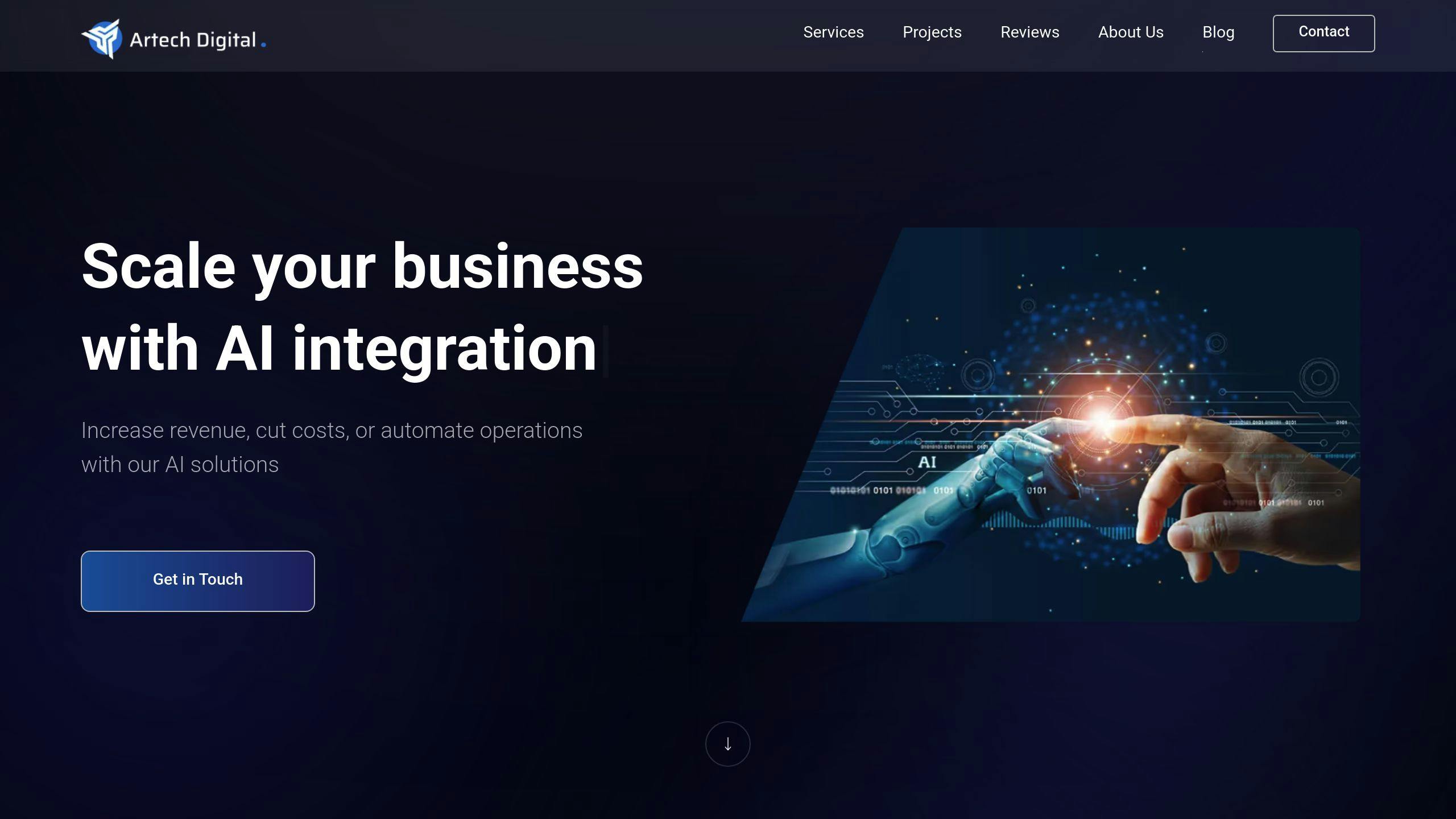
AI can save businesses 20-28% in costs, reduce error rates to less than 1%, and boost productivity by automating tasks that take hours or days manually. On the other hand, manual processes often face scalability issues, higher error rates (up to 20%), and rising labor costs over time.
| Metric | Manual Processes | AI Automation |
|---|---|---|
| Processing Speed | Hours to Days | Minutes to Hours |
| Error Rate | Up to 20% | Less than 1% |
| Scalability | Workforce-Limited | Highly Scalable |
| Cost Trend | Increases with Scale | Decreases Over Time |
For businesses aiming to improve efficiency, reduce costs, and scale operations, AI offers clear long-term benefits over manual methods. However, implementing AI requires upfront investment, proper employee training, and robust data security measures.
Choosing between AI and manual processes involves more than just upfront costs. It's essential to understand the financial dynamics that influence this decision.
Custom AI projects come with a hefty initial price tag, ranging from $2M to $200M [1]. Here's a breakdown of the typical expenses:
| Cost Component | AI Solution | Manual Process |
|---|---|---|
| Infrastructure & Setup | Hardware, cloud resources, system integration | Office space, equipment, onboarding |
| Development | Software development, AI model training | Process documentation, templates |
| Training | Technical staff certification | Employee operational training |
Manual processes often have steady but increasing labor costs, while AI offers a different cost structure. Over time, AI can reduce expenses by minimizing errors, cutting overhead, requiring less training for repetitive tasks, and handling data more efficiently.
Businesses that strategically adopt AI report nearly three times the return compared to those using it for isolated experiments [1]. This highlights the long-term financial advantages of AI when implemented effectively.
When looking at the bigger picture, AI's ability to scale and meet evolving business needs plays a major role in its overall cost efficiency. According to a 2023 Statista report, companies using AI solutions achieved savings of 20-28% [2].
For example, healthcare providers benefit from serverless functions that offer pay-as-you-go pricing, automatic scaling, optimized execution, and lower maintenance costs [4]. Similarly, AI-powered transaction monitoring and fraud detection align costs with activity levels, saving money during periods of low demand [4].
Artech Digital supports businesses with AI integration services, including custom AI agents and web applications. These tools help organizations manage costs effectively, achieve scalability, and maximize long-term ROI.
AI isn't just about cutting costs - it transforms workflows and boosts productivity across organizations.
AI dramatically cuts down the time spent on repetitive tasks. For instance, Google's data centers used machine learning to slash cooling energy use by 40%, improving overall Power Usage Effectiveness (PUE) by 15% [7].
| Task Type | AI Automation Impact | Manual Process Challenges |
|---|---|---|
| Content Creation | 25% faster output [6] | Time-intensive, inconsistent quality |
| Data Analysis | Real-time insights | Slow, manual reviews required |
| System Monitoring | Constant oversight | Limited by human focus |
But it’s not just about saving time - AI also tackles one of the toughest issues with manual processes: errors.
AI systems are great at reducing human errors and keeping operations consistent. They help businesses improve data accuracy and make better decisions.
How AI reduces errors:
AI shines when workloads increase. It handles growth without requiring extra resources or costs, making it a game-changer for businesses looking to scale.
AI achieves this through:
Many companies now use a hybrid model - AI handles routine tasks, while humans oversee complex decisions [6]. This balance ensures efficiency and keeps the human touch where it matters most. Plus, it helps businesses grow without skyrocketing costs, a key factor in maximizing ROI.
AI adoption doesn’t just streamline operations - it reshapes how businesses grow revenue and connect with customers.
AI-powered tools open up new ways to boost revenue by refining processes and creating more efficient workflows. Take a look at these examples:
| Revenue Impact Area | AI-Driven Approach | Manual Process Challenges |
|---|---|---|
| Sales Optimization | Cuts costs by 90% while increasing productivity | Labor-heavy and hard to scale |
| Cross-selling | Drives 35% of revenue (as seen with Amazon) | Misses opportunities due to inconsistency |
| Lead Generation | Achieves over 50% growth | Slowed down by manual qualification |
AI transforms customer interactions with personalization and proactive support. For instance, Erica, Bank of America's virtual assistant, has handled over 1 billion customer interactions. This kind of integration leads to:
"AI is not just a technological advancement; it's a strategic tool for businesses seeking to thrive in today's world." - FIU College of Business
By improving customer experiences, AI also helps businesses stay ahead of competitors through smarter strategies and better efficiency.
AI gives businesses a leg up by automating complex tasks and delivering results faster. For example:
"AI is the most strategic shift for organizations in the last century." - Mark Cowan, CEO at Put It Forward
With AI, businesses can outpace rivals by offering faster, more personalized, and efficient services. Those sticking to manual processes risk falling behind in an increasingly competitive landscape.
Switching from manual processes to AI solutions takes thoughtful planning and precise execution. Organizations need to tackle key challenges while keeping operations running smoothly.
Integrating AI into existing systems requires a clear, step-by-step approach to handle technical obstacles. A well-designed strategy minimizes disruptions and ensures a solid return on investment (ROI) by streamlining system integration.
| Integration Phase | AI Solution | Manual Process Challenge |
|---|---|---|
| Technical Setup | Automated data standardization & API integration | Complex legacy systems & data preparation |
| Workflow Adaptation | Phased implementation | Disruption to existing processes |
Serverless functions can ease this process by reducing the need for extensive infrastructure management and handling varying workloads efficiently [4]. Once the systems are in place, the focus shifts to preparing employees to work with these new tools.
For AI adoption to succeed, employees need the right training. However, 53% of workers feel their organizations aren't investing enough in skills development [3].
"AI adoption succeeds when it enhances workflows and supports human decision-making."
Training programs should prioritize hands-on experience with AI tools, adapting workflows, and continuous learning. As employees grow comfortable with AI-driven processes, attention must turn to safeguarding data and ensuring compliance.
Protecting data is a top priority, especially when 78% of UK companies admit to lacking adequate measures for managing AI-related breaches [5]. Strong security protocols not only prevent costly errors but also build customer trust, which directly impacts ROI.
| Security Aspect | Implementation Requirement | Benefit |
|---|---|---|
| Data Encryption | End-to-end protection | Secure data handling |
| Access Controls | Role-based permissions | Controlled access |
| Incident Response | Automated threat detection | Rapid breach response |
Organizations must adopt strict governance frameworks and comply with regulations like GDPR and CCPA. AI-powered security tools can analyze large datasets to detect and address potential threats in real time [6].
Artech Digital's integration services focus on secure AI implementation, combining strong security protocols with regulatory compliance. This allows organizations to harness AI's potential while keeping data safe.
In manufacturing, AI-driven quality inspections have reduced processing times by 30-50% and achieved a 95% defect detection accuracy. These measurable results highlight how AI can improve efficiency and precision across various industries.
| ROI Metric | Manual Process | AI Implementation |
|---|---|---|
| Error Rate | Up to 20% | Less than 1% |
| Customer Satisfaction | Baseline | 70% increase |
| Processing Speed | Standard | 70-90% faster |
| Cost Efficiency | Higher long-term costs | 20-28% savings |
With these figures in mind, companies need to assess how AI fits their specific objectives and operational hurdles.
"A holistic view of ROI is essential when evaluating AI automation." - Michael Fauscette, CEO at Arion Research.
Organizations often report the highest ROI in areas like:
For businesses aiming to boost ROI while managing the challenges of AI adoption, expert guidance can be a game-changer.

Artech Digital tackles common implementation obstacles with tailored solutions, such as custom AI agents, machine learning models, and advanced chatbots. Their Enterprise AI Pro package provides personalized integration, including LLM fine-tuning and tools designed for specific industries.

.png)
